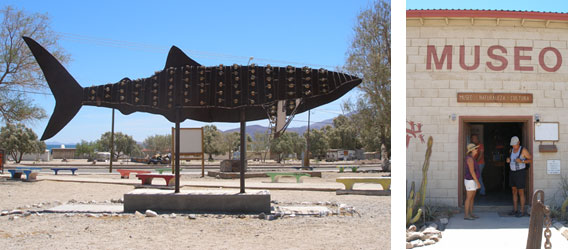On July 19 we arrived to the Bahia de Los Angeles area located in the “middle” Sea of Cortez and on the east coast of the Baja Peninsula. This was the farthest north we have ventured within the Sea, and initially we weren’t planning to go but Firefly was headed there so we decided to tag along!
B.L.A. is about 5 miles wide (east to west) and perhaps 15 miles north to south. It’s lovely, albeit wild looking like a small Lake Tahoe surrounded by big varied-color hills (little mountains?) in mostly shades of brown. There’s a valley at the south end of the bay filled with a forest of cacti and that was the greenest it was. We spent almost a month up there rotating between three anchorages about five miles apart.

The only town of substance (and it is small!) in the area is Bahia de Los Angeles Village, population 500-700. No cellular service in the area, nearest ATM/bank is a 2 ½ hour drive away in Guerro Negro. For those who need internet, satellite service is the only option and they are paying about $120 a month to connect, with limited bandwidth. There were a couple internet café’s in the village, we did not try them.
The only way to reach town is via dinghy, there are no docks or marinas. Most times we travelled in the dinghy from another anchorage approximately five miles away (our tender runs @ 20-25 mph in smooth water – in the mornings before the wind pipes up). One day we anchored Voyager just off the town (couple hundred yards) and still had to come in via dinghy (our other options were swimming or our kayaks). There were prettier anchorages in the area to stay in so we didn’t linger at anchor off the village.

One day six of us “carpooled” together on a single (trawler) boat to go to town. We had a nice breakfast, visited the cute little cultural/natural history museum and did some grocery shopping. The stores in B.L.A. are very basic. Our main objective is typically to get fresh produce; we knew to stock up on other items in the bigger cities and we have good refrigeration/freezer and dry storage capacity. The big trick is to find out what the days stores get deliveries; otherwise fruit/veggies can be pretty worn out from the heat as most stores are not air conditioned. You learn to buy what’s good when you see it and be flexible. There are not a lot of cold items to be found in B.L.A. groceries compared to more populous areas, especially minimal frozen items (this has to be a shipping challenge in the high heat). Apparently the village just got hooked up to conventional electricity a few years ago (generator before that).

We made several trips to the village for provisions and to periodically top off our diesel tanks. We have 150 gallons of fuel storage but being away from a conventional fuel dock (and/or marina electricity) for a month or more does tax our available supply. Once reaching the village we had a roughly 3/4 mile walk each way to transport our two 5-gallon fuel jugs, some of it over dirt/sand, to the local Pemex station. We made this “fuel run” about four times while in the area, once someone loaned us their car.
I don’t think I have ever sweat so much in my life this summer, even after living in Florida for 27 years. When we’re at anchor and it’s hot, we run our generator in the evening for 2-3 hours (important to charge our batteries in addition to the power we get from our solar panels) and we’ll also run our air conditioner/s to cool the boat down before bedtime. We could in theory run our genset all night but that eats up more fuel. A/C helps but on some nights by 2-3 am we were up sleeping on deck where it was a bit cooler with a hint of breeze.
